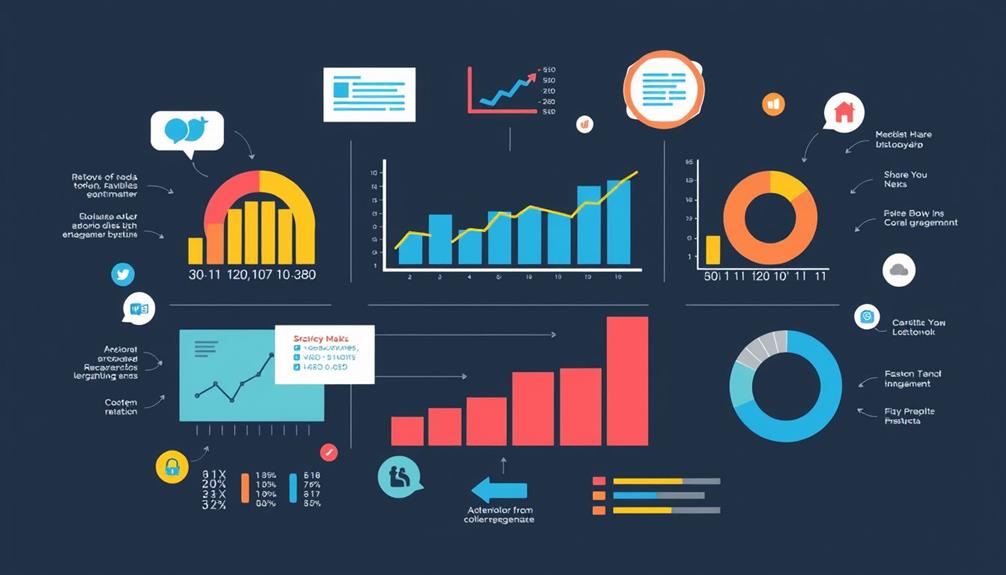Infographics can supercharge your SEO by making data visually engaging. They cater to visual learners, boosting user engagement by 94%. With infographics, your content's shareability skyrockets — they're shared three times more than text. To maximize their impact, use descriptive, keyword-rich file names and alt text, and guarantee they're mobile-friendly. Quality designs attract backlinks, enhancing your search visibility. Plus, promoting them on social media drives traffic to your site. With the right strategies, you'll keep your audience captivated and coming back for more insightful content. Discover how to elevate your infographic game further.
Key Takeaways
- Infographics boost SEO by enhancing engagement, with 65% of individuals processing information better through visuals and leading to a 40% higher response rate.
- Proper SEO techniques, such as keyword-rich file names and alt text, improve infographic visibility and search engine rankings.
- Infographics are shared three times more on social media, increasing brand exposure and driving traffic to websites.
- Consistent branding and high-quality visuals in infographics enhance professionalism and viewer retention, leading to better user experience.
- Measuring infographic success through social media interactions and website analytics informs future content strategies and boosts overall effectiveness.
Understanding Infographics and SEO
In today's digital landscape, understanding how infographics can enhance your SEO strategy is essential. Infographics serve as visual representations of information, making complex data more accessible and engaging. As a visual learner, you'll appreciate how these compelling visuals appeal to the 65% of individuals who process information better through images.
Additionally, leveraging AI advancements can further enhance the effectiveness of your visual content by optimizing how data is presented and interpreted.
When optimized effectively, infographics can greatly boost your SEO efforts. They're 40 times more likely to be shared on social media than text-based content, which can lead to valuable backlinks. To maximize this potential, focus on proper SEO techniques, such as using descriptive, keyword-rich file names and alt text. This helps search engines understand your infographic's content, improving its visibility in search results.
Moreover, infographics can drive organic traffic by meeting the demand for visual data in research and aligning with unique search intents. By integrating effective keyword strategies and ensuring your supporting content is of high quality, you can elevate your website's rankings.
This ultimately leads to increased user retention and lower bounce rates, making your infographics a powerful tool in your overall SEO strategy.
Benefits of Using Infographics

Using infographics can markedly enhance user engagement, making your content more appealing and memorable.
They serve as a powerful tool for leaders to showcase their success and build social proof, which can foster trust and loyalty among followers.
They're also highly shareable, which boosts your brand's visibility across social media platforms.
Plus, with their ability to simplify complex information, infographics help you connect with a wider audience effectively.
Enhanced User Engagement
Infographics can boost user engagement by an impressive 94%, making them a standout choice compared to traditional text.
When you incorporate visual content into your marketing strategy, you're catering to the 65% of the population who are visual learners. This means your audience will find it easier to understand and retain complex information, which aligns with effective email marketing strategies that emphasize personalized approaches.
Here are some benefits of using infographics to enhance user experience:
- Increased Retention: Infographics simplify complex data, making it easier to digest and remember.
- Higher Response Rates: Including infographics can lead to a 40% higher response rate compared to plain text, capturing your audience's attention effectively.
- Social Media Shares: Infographics are shared three times more frequently on social media, driving greater visibility and traffic to your content.
- SEO Benefits: Quality infographics attract backlinks, which can improve your website's search engine ranking.
Increased Shareability Potential
The power of infographics lies in their remarkable shareability, making them an essential asset in any marketing strategy. When you incorporate visual content like infographics, you tap into their impressive shareability potential. In fact, infographics are shared on social media three times more than other content types, considerably increasing your visibility and reach.
Here's a quick look at how infographics boost shareability:
| Metric | Impact | Benefit |
|---|---|---|
| Social Media Shares | 3 times more than other types | Greater audience engagement |
| Likelihood of Sharing | 40 times more | Enhanced brand exposure |
| Marketer Preference | 84% find them effective | Strong visual messaging |
Improved Brand Visibility
Visual content not only drives engagement but also considerably boosts brand visibility. When you use infographics, you're tapping into a powerful tool that amplifies your brand's reach. Infographics are three times more likely to be shared on social media than other content types, helping you connect with broader audiences.
By incorporating your logo and URL, you enhance long-term brand recognition, as visual content is 40 times more shareable than text. Additionally, implementing a solid keyword and content strategy can further enhance the effectiveness of your infographics, ensuring they reach the right audience.
Here are some ways infographics improve brand visibility:
- Enhanced user engagement: 94% of viewers engage more with compelling visuals.
- Simplified information: Infographics make complex data easier to understand, increasing message retention.
- Increased shareability: Infographics are more likely to be shared, expanding your audience reach.
- SEO benefits: Consistent use of high-quality infographics attracts backlinks, boosting organic traffic and online visibility.
Essential Tools for Infographic Creation

When you're ready to create stunning infographics, knowing the right tools can make all the difference.
From user-friendly design software like Canva to advanced options like Adobe Illustrator, there's something for everyone.
Plus, data visualization tools can help you effectively present your information, ensuring your infographics stand out.
Popular Design Software Options
Creating stunning infographics requires the right tools, and several design software options can help you achieve that goal. Whether you're a beginner or a professional, you'll find a variety of platforms that cater to your needs for creating an infographic that stands out.
Additionally, contemplating the therapeutic benefits of visual content can enhance your messaging, much like how aromatherapy techniques can promote relaxation and well-being.
Here are some popular design software options to reflect on:
- Canva: User-friendly templates and drag-and-drop features make it perfect for non-designers who want to create visually appealing infographics quickly.
- Adobe Illustrator: Ideal for professional graphic designers, it offers advanced capabilities for intricate customizations and high-quality visual content.
- Piktochart: Specializes in data-driven infographics, allowing easy integration of data from spreadsheets and charts for engaging visuals.
- Venngage: Known for its collaboration features, it lets teams work together, customizing templates to fit their branding needs.
These tools can greatly enhance your ability to create compelling visual content. By selecting the right software, you'll streamline the process of designing and guarantee your infographics effectively communicate your message.
Data Visualization Tools Overview
Data visualization tools play an essential role in transforming complex information into easily digestible graphics. When you're creating valuable content, choosing the right tool can make all the difference. Here's a quick overview of some top options:
| Tool | Features | Best For |
|---|---|---|
| Canva | User-friendly templates, accessible design | Beginners seeking ease |
| Adobe Illustrator | Advanced design capabilities | Professional quality designs |
| Piktochart | Data-driven templates for statistics | Engaging data visualization |
| Venngage | Customization and team collaboration | Branding and teamwork |
| Infogram | Interactive infographics with dynamic elements | Engaging audience experience |
Each of these data visualization tools offers unique advantages tailored to different needs. Canva is great for those starting, while Adobe Illustrator suits seasoned designers looking for intricate designs. Piktochart excels in showcasing statistics effectively, and Venngage promotes teamwork on projects. Finally, Infogram enhances audience engagement through interactive elements. By selecting the right tool, you'll be better equipped to present your data in a visually appealing manner, helping your audience grasp your message effortlessly.
User-Friendly Template Resources
Finding the right template resources can greatly streamline your infographic creation process. With user-friendly templates, you can enhance your content marketing efforts without spending hours on design. Additionally, incorporating elements like essential oils for relaxation can inspire creative themes for your infographics.
Here are some top tools to evaluate:
- Canva: Offers a variety of easy-to-use templates perfect for beginners, allowing quick and efficient creation of visually appealing infographics.
- Piktochart: Specializes in data-driven templates, helping you present complex data in a clear and engaging manner.
- Venngage: Provides a wide range of customizable templates, ensuring your infographics align with your branding and messaging needs.
- Infogram: Stands out with interactive templates that boost user engagement and retention through dynamic visual content.
If you're looking for more advanced options, Adobe Illustrator delivers extensive design capabilities and templates tailored for high-quality, professional infographics.
By leveraging these resources, you can create compelling visual content that effectively communicates your message, making your infographics not just attractive but also functional in supporting your overall content marketing strategy.
Designing Engaging Infographics

Engaging infographics are a powerful tool for communicating complex information in a visually appealing way. To create infographics that truly capture attention, start with consistent branding. A well-defined color scheme and high-quality visuals enhance professionalism and make your content more engaging for viewers.
Consider using data visualization techniques similar to those found in home cleaning service options, which can help present information in a clearer manner key factors in choosing a service.
Incorporating credible data sources not only builds trust but encourages users to share your infographic, increasing its reach and engagement potential. Remember, over 50% of web traffic comes from mobile devices, so design your infographics for mobile responsiveness. This guarantees accessibility and enhances the user experience.
Additionally, employ a clear narrative flow to guide viewers through the complex information you're presenting. This approach improves comprehension and helps retain key messages.
To take your infographics to the next level, consider adding interactive elements. Interactive content considerably boosts engagement by keeping users on the page longer and encouraging them to explore the material more deeply.
Optimizing Infographics for Search Engines

Creating visually engaging infographics is just the beginning; optimizing them for search engines is what guarantees they reach a broader audience.
To effectively optimize infographics, you'll want to focus on several key strategies:
– Use descriptive, keyword-rich file names and include ALT text to help Google understand the image content.
Additionally, making sure that your infographics can be easily shared and linked to can enhance their visibility and reach, much like how protecting your savings requires careful planning and research.
- Incorporate relevant keywords within the infographic content and meta descriptions to boost search visibility.
- Make certain your infographics are mobile-friendly and load quickly, as these factors impact user experience and search engine rankings.
- Utilize high-quality images and credible sources to increase the likelihood of backlinks, which are essential for improving SEO.
Promoting Your Infographics Effectively

While crafting an eye-catching infographic is essential, promoting it effectively is what truly amplifies its impact. Start by leveraging social media platforms; studies show that infographics are shared three times more than other content types, driving significant traffic to your website.
Effective advertisement formats can enhance visibility and engagement with your infographic. Don't forget to collaborate with influencers. Their endorsement can expand your reach and expose your infographic to new audiences.
Consider submitting your infographics to specialized directories. This enhances discoverability and provides opportunities for valuable link building, which can further boost your search engine rankings.
Additionally, utilize email marketing to distribute your infographics to your subscriber base. Visual content can improve engagement rates by up to 40%, making it an effective way to connect with your audience.
Measuring Infographic Success

When it comes to measuring the success of your infographics, focusing on key engagement metrics is essential.
These metrics help you understand viewer interest and content effectiveness. In today's competitive landscape, understanding cybersecurity measures is crucial to ensuring your infographic's safety and integrity.
Here are some critical areas to track:
- Social Media Interactions: Monitor shares, likes, and comments to gauge audience engagement.
- Website Analytics: Use tools like Google Analytics to assess increases in traffic and average time spent on the page post-publication.
- Backlink Generation: Keep an eye on the number of backlinks your infographic attracts, as this can enhance SEO performance and indicate its value.
- Viewer Feedback: Conduct surveys or feedback forms to gather insights on how users perceive and utilize your infographic.
Future Trends in Infographic Marketing

As you look to measure the success of your infographics, it's also important to keep an eye on future trends in infographic marketing. One notable trend is the increasing demand for mobile-optimized content. Since mobile traffic accounts for over 50% of web visits, your infographics need to be visually engaging and easily accessible on smaller screens.
Interactive infographics are also gaining traction. With 70% of marketers finding interactive content more effective for engagement, incorporating elements that draw users in will cater to shorter attention spans.
Additionally, the use of augmented reality (AR) is emerging, allowing for immersive experiences that enhance user interaction.
As AI tools become more integrated into content creation, 60% of marketers plan to leverage AI for generating infographic designs and data analysis. This can streamline your infographic production process considerably.
Finally, the trend toward data-driven storytelling is expected to grow, as 80% of consumers prefer visual content that simplifies complex information, making it easier to digest and share.
Conclusion
In the vibrant world of digital marketing, your infographics can shine like stars against a dark sky. By weaving together compelling visuals and strategic SEO, you're not just creating content; you're crafting stories that captivate and inform. So, as you design and promote your infographics, imagine them as beacons guiding curious minds to your brand. Embrace these tools and techniques, and watch your visual content not just work harder, but soar higher in the crowded online landscape.










